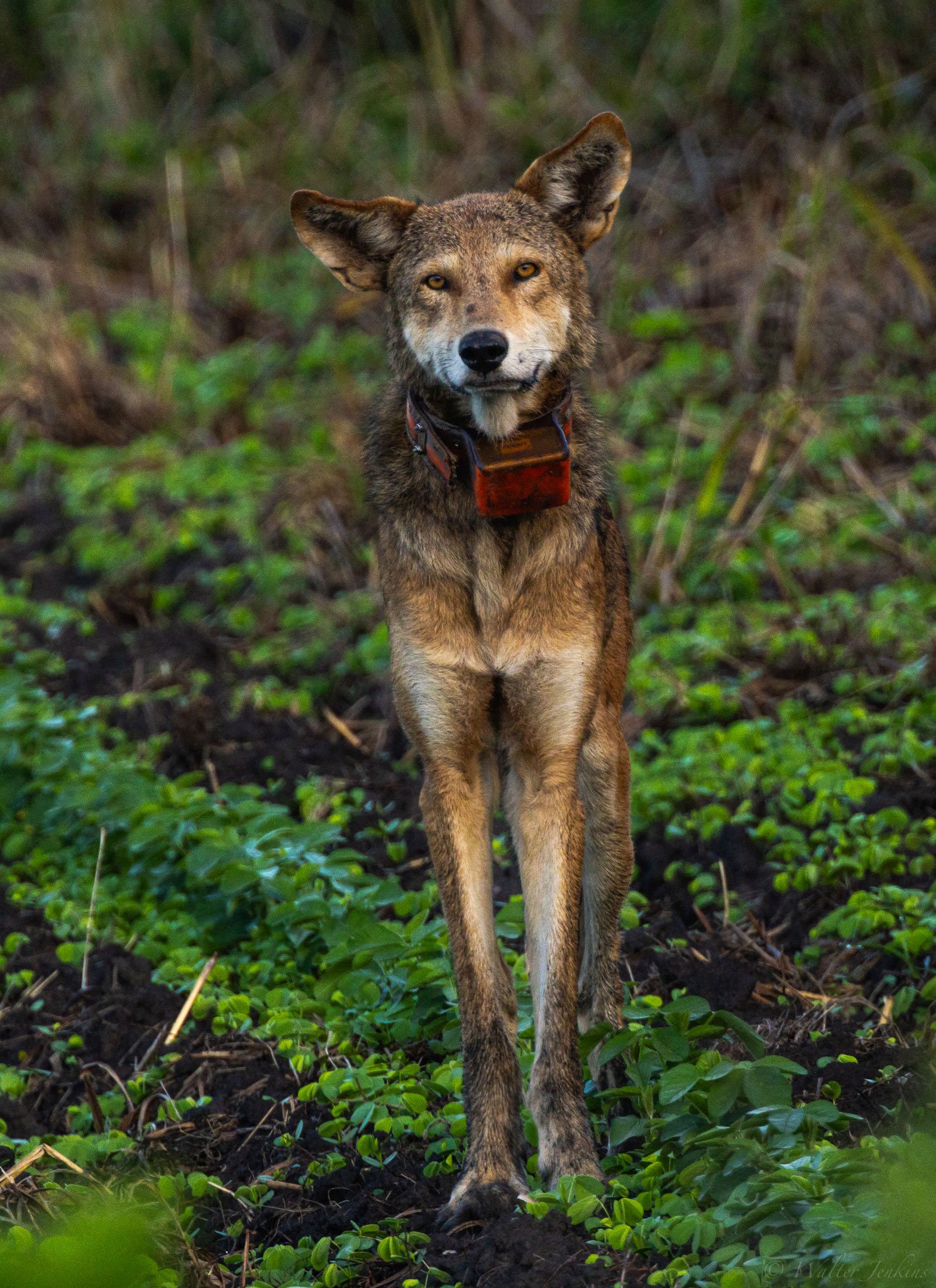Goodbye, Airplane Ears
I’m an average dad. I make it to my kids’ soccer games. I put food on the table, help them with homework, and tuck them in at night.
But there are SuperDads out there. I have seen them at soccer tournaments: they have tents set up to shade and massage their kids in between games. They wear jerseys with their kids’ names on the back. They will do anything for their children.
There are SuperDads in the natural world, too—fathers who sacrifice everything for their offspring. Male glass frogs guard their eggs 24/7 for weeks, starving themselves to shield their babies from predators. Male seahorses feed and carry fertilized eggs in their pouches. Male sandgrouse dip their wings in distant watering holes and then fly waterlogged across the desert to their thirsty young, which suck water from their father’s feathers.
Last month, we lost one of the world’s greatest SuperDads—and one of the world’s most endangered animals.
A red wolf named Airplane Ears was struck by a vehicle and killed. A necropsy is pending. No additional details have been released by U.S. Fish and Wildlife Service.
Fewer than 25 red wolves remain in the wild. Airplane Ears sired 11 of them.
Named for his exceptionally long ears that extend somewhat horizontally, Airplane Ears was one of the most important wolves in the history of the red wolf recovery program.
Red wolves once roamed throughout the Eastern United States, but by the 1980s they had been nearly hunted to extinction. So the last remaining wolves were brought into captivity. In 1987, they released some of their offspring into North Carolina’s Alligator River National Wildlife Refuge.
Red wolves quickly flourished, and by 2006, more than 120 red wolves roamed 1.7 million acres in eastern North Carolina. The red wolf’s recovery was hailed as the most successful animal reintroductions to the wild ever achieved, and biologists began planning for additional red wolf reintroductions in other locations.
Then restrictions were loosened on coyote hunting. Red wolves can be easily mistaken for coyotes, and a 375% increase in red wolf shooting deaths followed. Red wolves went from hero to nearly zero. Their population crashed, and rather than attempt to curb the shooting deaths, the U.S. Fish & Wildlife Service planned to abandon its red wolf recovery program entirely. As few as seven red wolves survived in the wild by 2019.
But the few remaining underdogs wouldn’t give up—and neither would the dedicated biologists and conservationists fighting for them. Environmental groups sued—and won—forcing the U.S. Fish & Wildlife Service to restart its red wolf recovery program.
It’s already working, and a big reason for its renewed success is Airplane Ears. Last spring, for the first time in many years, red wolf pups were born in the wild. Airplane Ears was their father.
Red wolves mate for life, and Airplane Ears and a female red wolf named Pam are lifetime breeding partners. After raising five pups last year, Airplane Ears and Pam gave birth to five more pups this spring. The couple had proven to be such good caretakers of their young that biologists added a sixth pup to their litter. The sixth pup had been born at a zoo, and it was transferred to the care of Airplane Ears and Pam soon after birth. Airplane Ears and Pam have raised their adopted pup as one of their own.
All 11 of their pups have grown into healthy yearlings and sub-juveniles. One reason is Airplane Ears’ protective care. He fed and nurtured his pups and taught them how to hunt. He kept his pups close to him and was always scanning his surroundings for potential dangers.
When people were around, Airplane Ears would act as a decoy. He would intentionally walk out to attract attention to himself so that his pups could secretly scramble to safety. Several times, biologists have observed Airplane Ears strut out into a field to distract visitors. Meanwhile, just behind the unknowing crowd, his pups were racing for cover.
Now, without their father around, many of the pups are wandering closer to people—and to the busy highway that killed their father. Gunshots are still the leading cause of death for red wolves, but vehicle collisions are a close second.
Save Red Wolves—an alliance of organizations and individuals concerned about red wolves—is working to create red wolf crossings and other road safety measures in eastern North Carolina. Save Red Wolves also honors Airplane Ears with a tribute at saveredwolves.org, which provides photos, videos, and biographies of the remaining red wolves—and updates on red wolf recovery.
Red wolves are still one of the most imperiled species on the planet. Another male red wolf was illegally shot and killed this summer. U.S. Fish and Wildlife and the Center for Biological Diversity are offering a $15,000 reward for information leading to successful prosecution.
Despite the recent losses, red wolves are making a comeback. Airplane Ears has been an essential part of their remarkable resurgence. He and Pam have doubled the number of red wolves in the wild and given the species a fighting chance. Last month, U.S. Fish and Wildlife Service released a new Red Wolf Recovery Plan that aims to expand the population to 740 and launch two additional reintroduction sites in the East in the coming decades.
Airplane Ears is gone. But across moonlit swamp forests, in the shrill howls of his offspring, are echoes of their father.
Follow the Pack: Save Red Wolves provides photos, videos, and biographies of the remaining red wolves. Stay updated on Pam and her pups at saveredwolves.org.
Cover photo: Airplane Ears.







